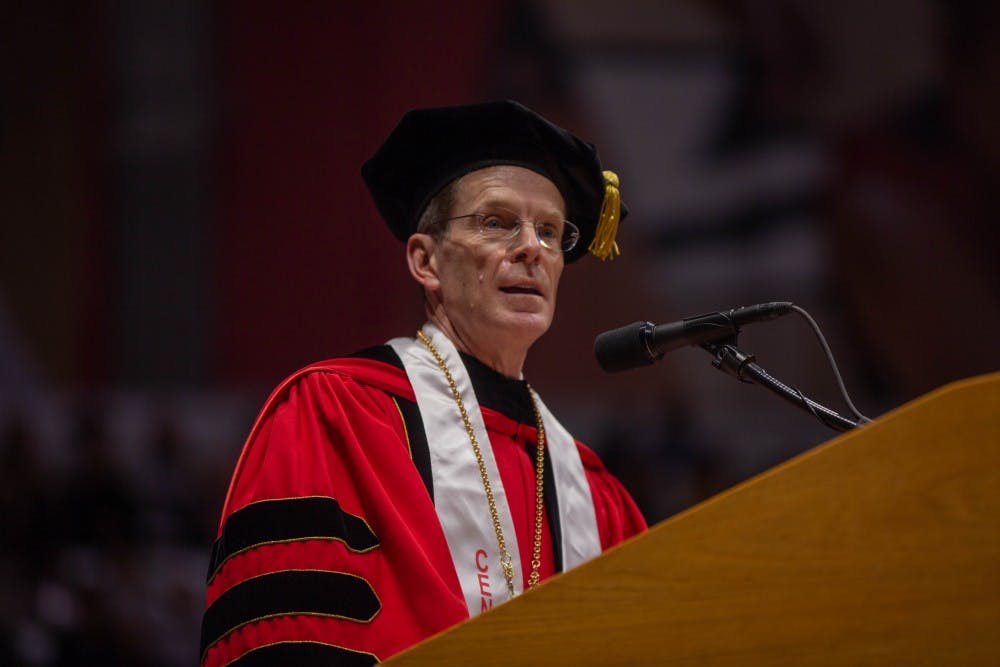In response to the COVID-19 pandemic and its consequences, Ball State president Geoffrey Mearns updated the university community on its plans for the summer and fall 2020 semesters in an email Friday.
These updates include, but are not limited to, the university's plans for new student recruitment, the upcoming fiscal year, hiring practices and salary increases, the email states.
Contingency planning groups:
Susana Rivera-Mills, provost and executive vice president for academic affairs, has created a fall contingency planning group, to develop academic recommendations — including the possibility of beginning the fall 2020 semester with a continuation of remote learning for larger classes or some variation of hybrid learning.
The group, which will work with her and the academic deans, will ask for feedback and input from faculty and department chairs during the planning process.
Sue Hodges Moore will lead a parallel contingency planning group, comprised of representatives of every division of our University, to help identify, evaluate and plan for the other obstacles and issues that may arise when transitioning to more normal operations.
These operations include classrooms, labs, the library, information technology support, residence halls, dining halls, recreational facilities and events such as conferences, concerts, shows and athletics.
Freshmen recruitment and registering for classes:
Paula Luff, Ball State's new vice president of enrollment planning and management, is working with her team to recruit the next freshman class. They have created virtual tours and information sessions for high school seniors admitted to the fall 2020 class.
They have also worked with deans and the faculty in their engagement strategies which include initiatives to enhance summer enrollment with the support of the university's marketing and communications.
Ro-Anne Royer Engle and her team across multiple divisions are developing and implementing outreach initiatives to encourage returning undergraduate students to register for classes for 2020-21 academic year.
Given how the spring 2020 semester is ending, Mearns said it will be important for the university to provide regular support and extra assistance to Ball State students.
Upcoming fiscal year planning:
Alan Finn, vice president for business affairs and treasurer, will lead the development of the operating budget for next fiscal year which begins July 1. Mearns said this was going to be difficult given the impact the pandemic is having on the economy and uncertainties about student enrollment.
In contrast to some universities, Mearns said Ball State is well positioned for fiscal challenges — projecting a modest positive operating margin at the end of this fiscal year. However, he said it is important to sustain summer enrollment and deliver summer courses as efficiently as possible in order to achieve a positive final result.
Ball State, he said, has solid credit rating and adequate financial reserves to weather a temporary unexpected emergency. It will also receive some one-time financial support from the CARES Act, the recently passed federal stimulus law.
Ball State revenues at risk:
Mearns said Ball State's major sources of revenue — tuition and state operating appropriations — are at risk due to the economic impact of the pandemic.
Its tuition revenue may decline substantially because it is likely that enrollment will decline. He said some people are predicting United States' college enrollment may drop by more than 10 percent next year. State appropriation is at risk because of the recent sharp decline in economic activity.
In the wake of the Great Recession, he said Ball State's state appropriation was reduced by approximately 6 percent. If that were to happen next year, its state appropriation would be reduced by approximately $8 million.
Due to these threats, Mearns said he has provided the all vice presidents with a range of budget reduction targets and asked them to provide their preliminary budget planning scenarios to him by May 15.
He said these reduction targets might be reasonable enough to be fully implemented next year, or so significant that they may need to be phased in over more than one fiscal year.
Due to the challenges faced by the university, Mearns said it will have to reduce or eliminate some services and programs and it is likely that the university will have to reduce personnel in some divisions and colleges.
Hiring, raises and the Strategic Imperative Fund:
For the time being, Mearns said he will not approve any new searches for faculty or staff, unless he determines that the position is critical. Vice presidents will also pause previously-approved searches, unless they determine that completing the search will not affect their ability to develop a strategic budget reduction plan.
Due to extraordinary and uncertain budget challenges, he said there will not be an annual salary increase next year.
He said he will not approve any proposal, unless determined that the proposal meets one or more of the three guiding principles — student success, affordability and excellence. If other proposals have compelling merit, he will defer his final decision until the fall semester, when he will have more information about Ball State's budget and financial position.





